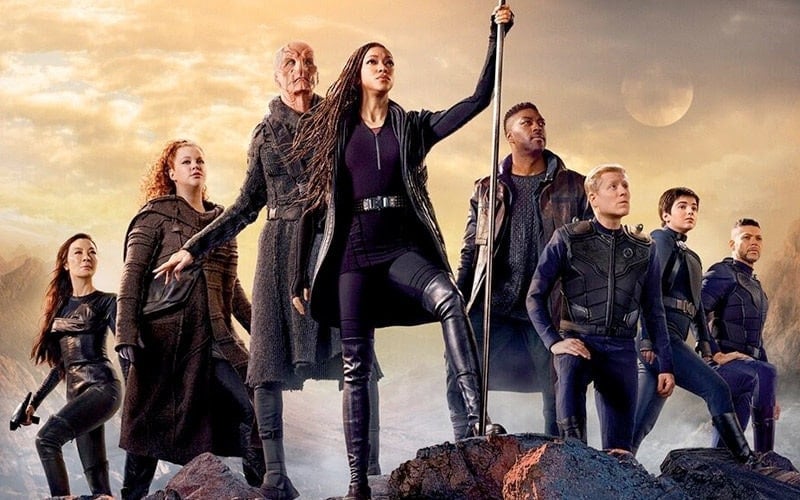‘Star Trek: Discovery’ Season 3 Review: Reconnecting While Wrestling with Trauma

Star Trek: Discovery, created by Bryan Fuller and Alex Kurtzman, wrestles with themes of reconnection and trauma in its third season.
While my favorite season of Star Trek: Discovery is still the second one, this soft reboot created a whole new world order while still honoring what came before. Even with Federation being weakened, I could feel the values of “Star Trek” throughout the whole season.
Michael Burnham finally came into her own as a leader, and her leadership character arc this season makes it worth waiting to see her as Captain of Discovery. In the first episode, “The Hope is You, Part 1”, Michael is violently disconnected from her adopted family and the U.S.S. Discovery. She has to forge a new, more rebellious, and off-the-cuff identity with Book as a courier. When Michael found Saru and the rest of the U.S.S. Discovery crew again, she has to slowly find a way to merge her new way of thinking with her identity as a Starfleet Commander.
Admiral Vance and Saru try to bring her back into the Starfleet way of thinking even though the whole landscape has changed. Michael is demoted from the first officer back to the chief science officer. In the closing episodes, she finds her place as a leader by thinking differently than most other officers. While Michael still embodies Federation ideals, for example, “Infinite Diversity in Infinite Combinations” and compassion, she doesn’t cling to all the regulations. Michael’s out of the box thinking lands her the promotion to Captain of the U.S.S. Discovery.
Star Trek: Discovery Season Three finally starts to develop the bridge crew into three-dimensional characters. One of the significant flaws in the first two seasons of Discovery is that only a few characters were fully developed. The bridge crew, who are a large part of the series, were left flat, so any storyline involving them was hard to invest in emotionally. A prime example of that is Airiam in the second season. Her backstory was packed into two-episode making her character feel forced. Subsequently, Airiam’s death doesn’t mean a lot. But in Season Three, there is a considerable improvement in that area, with Lieutenant Keyla Detmer as the prime example. Keyla is the helmsmen of the U.S.S. Discovery.
Throughout Season Three, Keyla deals with the trauma of flying the U.S.S. Discovery, 930 years into the future and crashing into a mysterious planet. In the first few episodes, Keyla freezes or hesitates during high-stress battles. This culminates with her freaking out during Captain Saru’s dinner for the bridge crew. Finally, Keyla speaks to Dr. Culber about her PTSD. This storyline ends with the helmsman reigniting her love of flying. When Keyla manually flies Book’s starship for a critical strike against the Emerald Chain, her confidence and joy from piloting a starship come back. Keyla’s character development leads the audience to feel emotionally invested in her.
Trauma features a significant part of all the main characters’ story arcs this season—everybody in the U.S.S. Discovery is dealing with the anguish of leaving their lives behind in the past. The Burn has left the Federation with low morale. Book suffers from no longer being part of his family on Kweijan. Adira Tal feels the turmoil from being joined with a Trill symbiont and losing their boyfriend, Grey. Mirror Phillipa has to wrestle with the emotional upheaval from her time disease and how she has changed from her living in the Prime Universe. All of this trauma echoes what is happening in the real world and shows how suffering can lead to growth.
All of these characters go through a fantastic transformation that leads to them having a happier life. Book falls in love with Michael and becomes part of the U.S.S. Discovery crew. Adira finds a family with Culber and Stamets. Mirror Phillipa gets another chance to build a better world back in the past. The whole crew of the U.S.S. Discovery reconnects with the Federation finding their place in this time.
The new Federation figures out its reason for existence by reconnecting with its values and community. Since the Burn, Starfleet, and the entire Federation of Plants have shrunk. Their headquarters are in this invisible forcefield. Their limited communication arrays and not having enough dilithium to fly long distances makes it impossible for the Federation to have a significant footprint in the universe.
The Federation lost many of its members like Ni’Var (the unified Romulans and Vulcans planet) and are no longer allied to other worlds like Trill. Starfleet doesn’t explore the universe or helps others. Instead, Starfleet goes around putting out small fires—the U.S.S. Discovery coming in with a jump capable spore drive allows them to make a real difference. Fleet Admiral Vance is resistant at first. But slowly, Captain Saru and Michael change his mind. By reaching out, helping, and opening up dialogues with the people of Kwejian, Trill, and Ni’Var, the Federation starts to re-build. The U.S.S. Discovery doesn’t just reconnect with the Federation but helps them find their mission again.
My only complaint about this season is the “First Officer/Acting Captain Tilly” plotline. Tilly is ready to be promoted to the rank of lieutenant. She has not earned the ability to be a long-term leader. Tilly’s lack of knowledge and experience leads the U.S.S. Discovery to being hijacked by the Emerald Chain. Next Season, Michael can mentor her friend and give her more experience.
Overall, I enjoyed Star Trek: Discovery Season Three. I would recommend watching it to anybody who loves the Trek Universe or mindful science fiction.


Responses